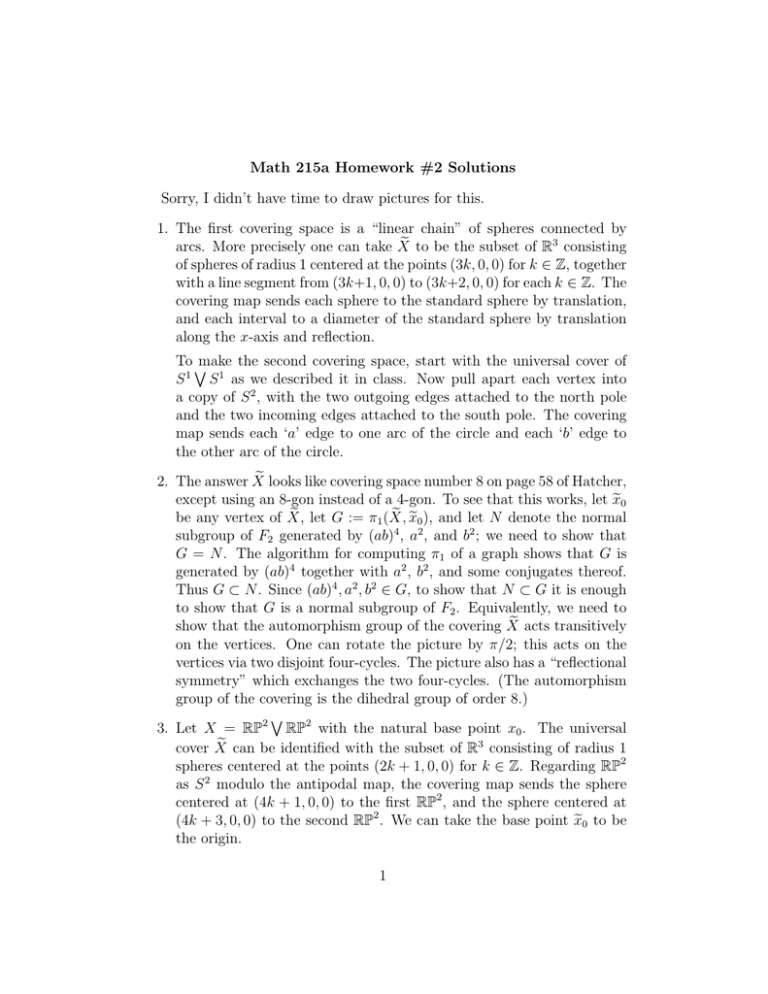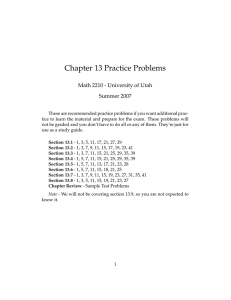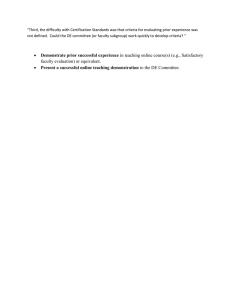Math 215a Homework #2 Solutions Sorry, I didn`t have time to draw
advertisement

Math 215a Homework #2 Solutions
Sorry, I didn’t have time to draw pictures for this.
1. The first covering space is a “linear chain” of spheres connected by
e to be the subset of R3 consisting
arcs. More precisely one can take X
of spheres of radius 1 centered at the points (3k, 0, 0) for k ∈ Z, together
with a line segment from (3k+1, 0, 0) to (3k+2, 0, 0) for each k ∈ Z. The
covering map sends each sphere to the standard sphere by translation,
and each interval to a diameter of the standard sphere by translation
along the x-axis and reflection.
To W
make the second covering space, start with the universal cover of
1
S
S 1 as we described it in class. Now pull apart each vertex into
a copy of S 2 , with the two outgoing edges attached to the north pole
and the two incoming edges attached to the south pole. The covering
map sends each ‘a’ edge to one arc of the circle and each ‘b’ edge to
the other arc of the circle.
e looks like covering space number 8 on page 58 of Hatcher,
2. The answer X
except using an 8-gon instead of a 4-gon. To see that this works, let x
e0
e
e
be any vertex of X, let G := π1 (X, x
e0 ), and let N denote the normal
subgroup of F2 generated by (ab)4 , a2 , and b2 ; we need to show that
G = N . The algorithm for computing π1 of a graph shows that G is
generated by (ab)4 together with a2 , b2 , and some conjugates thereof.
Thus G ⊂ N . Since (ab)4 , a2 , b2 ∈ G, to show that N ⊂ G it is enough
to show that G is a normal subgroup of F2 . Equivalently, we need to
e acts transitively
show that the automorphism group of the covering X
on the vertices. One can rotate the picture by π/2; this acts on the
vertices via two disjoint four-cycles. The picture also has a “reflectional
symmetry” which exchanges the two four-cycles. (The automorphism
group of the covering is the dihedral group of order 8.)
W
3. Let X = RP2 RP2 with the natural base point x0 . The universal
e can be identified with the subset of R3 consisting of radius 1
cover X
spheres centered at the points (2k + 1, 0, 0) for k ∈ Z. Regarding RP2
as S 2 modulo the antipodal map, the covering map sends the sphere
centered at (4k + 1, 0, 0) to the first RP2 , and the sphere centered at
(4k + 3, 0, 0) to the second RP2 . We can take the base point x
e0 to be
the origin.
1
To find the other coverings, note that in general, π1 (X, x0 ) acts on the
e where [f ] ∈ π1 (X, x0 ) sends [γ] ∈ X
e
left on the universal cover X,
b corresponding to a subgroup
to [f · γ]. The connected covering X
e by the restriction of this
G ⊂ π1 (X, x0 ) is obtained by modding out X
action to G.
In our particular case, the left π1 (X, x0 ) action on the universal cover
e is given as follows. Let a and b denote the generators of π1 of the
X
first and second RP2 ’s, respectively. Then a reflects the whole picture
through the point (1, 0, 0), while b reflects through the point (−1, 0, 0).
In particular, ab translates everything 4 units to the right.
We now determine the nontrivial subgroups G of π1 (X, x0 ) and the
b If G does not contain a reflection,
corresponding covering spaces X.
k
b is a
then G is generated by (ab) for some positive integer k, so X
cyclic chain of 2k spheres. Now suppose that G contains a reflection.
b is a half-infinite chain of spheres, with an RP2
If G has order 2, then X
attached to the end. If G also contains a translation (ab)k where the
b is a chain of k − 1
positive integer k is as small as possible, then X
2
spheres with an RP attached to each end.
4. This is one of those problems where it is probably easier to do it yourself
than to read a solution.
5. By a previous homework problem, if X is a connected graph with v
e x
vertices and e edges, then π1 (X, x0 ) ' F (e − vW+ 1). Now let (X,
e0 )
1
be the path connected based covering space of n S corresponding to
e is a graph with k vertices and kn edges. So
the subgroup G. Then X
e x
G = π1 (X,
e0 ) ' F (kn − k + 1).
6. Since the universal covering space of T n is Rn , any path connected
e of T n is isomorphic to Rn /G where G is a subgroup
covering space X
of Zn . By basic algebra, there are vectors v1 , . . . , vm ∈ Zn , which are
linearly independent over R, such that G = span(v1 , . . . , vm ). We can
perform a real change of basis sending vi to the ith standard basis vector
e is homeomorphic to
ei . Then X
Rn
Rm
'
× Rn−m = T m × Rn−m .
span(e1 , . . . , em )
span(e1 , . . . , em )
2
e of S 1 W S 1 corresponding to
7. We will first find the covering space X
e
the commutator subgroup G ⊂ F (2), and then find a basis for π1 (X),
regarded as a subgroup of F (2).
e be the “grid”
Let X
e := (Z × R)
X
[
(R × Z) ⊂ R2
e Define a covering p : X
e → S 1 W S 1 by sending
with x
e0 := (0, 0) ∈ X.
the horizontal edges of the grid to the ‘a’ circle and the vertical edges
e x
of the grid to the ‘b’ circle. I claim that (X,
e0 ) corresponds to the
commutator subgroup
G of F (2). To see this, given an element f ∈
W
F (2) = π1 (S 1 S 1 , x0 ), let m denote the total exponent of a and let n
e from
denote the total exponent of b in f . Then f lifts to a path in X
e x
e i.e.
(0, 0) to (m, n). Now f is in p∗ π1 (X,
e0 ) iff f lifts to a loop in X,
m = n = 0. It is not hard to check that the latter condition holds iff f
is in the commutator subgroup. (That is, the map sending f 7→ (m, n)
defines an isomorphism from the abelianization of F (2) to Z2 .)
e x
Now we need to find a free basis for π1 (X,
e0 ). Following the algorithm,
e consisting of the x-axis
we choose the maximal spanning tree of X
together with all of the vertical lines. Each remaining edge connects a
pair of lattice points (m, n) and (m−1, n) where m ∈ Z and n ∈ Z\{0}.
We then get the basis
{am bn a−1 b−n a−1−m | m ∈ Z, n ∈ Z \ {0}}.
(1)
One can then do a change of basis to obtain the nicer basis
{[am , bn ] | m, n ∈ Z \ {0}}.
(2)
To see this, note that the m = 1 elements in (1) agree with the m = 1
elements in (2). The m > 1 elements in (1) are given in terms of the
nice basis (2) by
am bn a−1 b−n a−1−m = [am , bn ][am−1 , bn ]−1 .
The m ≤ 0 elements in (1) are handled similarly.
8. No extra credit for me this week.
3


